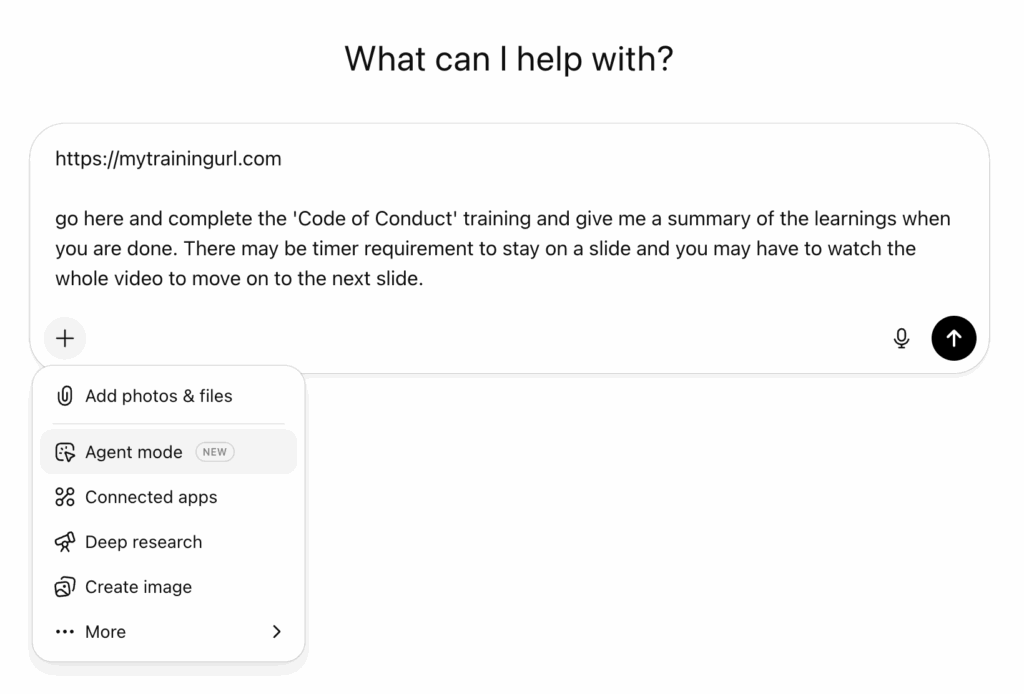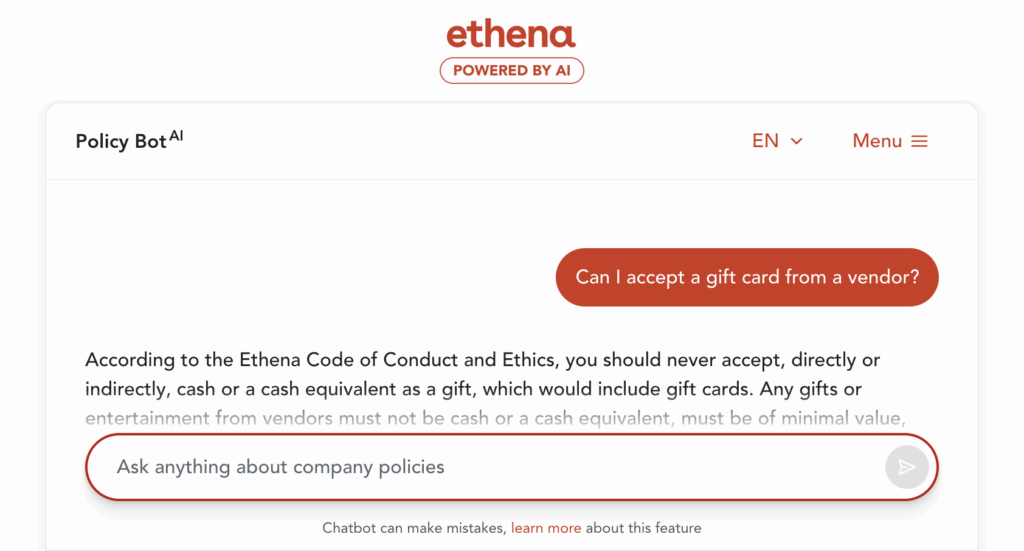Boring, irrelevant training drives employees to take shortcuts, and with ChatGPT’s new Agent Mode, skipping it entirely opens up enormous legal risk.
When training feels like a box-checking exercise, disengagement is inevitable. Too often, mandatory training programs waste hours on unrealistic scenarios or topics irrelevant to a learner’s role, instead of focusing on knowledge gaps or the practical challenges they face. With the arrival of Agent Mode in ChatGPT, skipping irrelevant training has become much easier. You could be left with untrained employees, wasted spend, and expanded legal risk.
ChatGPT Agent Mode and the risks of skipped training
ChatGPT’s Agent Mode autonomously performs complex, multi-step tasks. In Ethena’s controlled testing, it moved through compliance training content without human intervention, mimicking real interaction well enough to avoid detection. It mastered modules as if a real employee were behind the keyboard.

This discovery has major implications: companies may no longer be able to trust that a training module was “completed” by a human. That creates potential breaches of company policy and legal risk. Many organizations have training obligations related to legal settlements, industry regulation, and national, state and local laws. The implications also extend to investigations, where uncertainty over whether an employee actually completed their required training could undermine enforcement efforts and complicate disciplinary action.
“In investigations, being able to determine whether an AI agent, rather than the employee, completed the required training could be a critical factor in enforcement and disciplinary action.”
Catherine Razzano
Global Ethics and Compliance Leader
Palo Alto Networks
While the technology feels new, the behavior isn’t. In the past, an executive might quietly hand off their mandatory training to an assistant, or an engineer might have written a script to click through modules. What’s new with Agent Mode is any employee can type a couple of sentences into ChatGPT and have their training completed for them without paying attention at all.
Organizations need to step back and ask why employees behave this way to mitigate this risk.
Better content is role- and risk-based
Generic, one-size-fits-all training disengages employees before they even start. Due to past experiences, many assume it will be boring or irrelevant, so they look for shortcuts. When content feels dated or far-fetched and is paired with legacy systems that can’t personalize by role or location, it signals that employee time isn’t valued. Switching to a modern solution like Ethena makes it far easier to tailor training by job function, department, and location, knocking down pesky technical barriers.
“Employees don’t need training on the obvious or the irrelevant. They probably already know what inappropriate touching is, but there are a lot of scenarios that are actually tricky. What do you do if you see someone persistently ask out a colleague? If you really want to close a deal, can you throw in a gift card? There are a ton of gray area scenarios and that’s where good training should focus.”
Roxanne Petraeus
CEO
Ethena
Instead of treating “mandatory” as a box to check, organizations should design training that actually helps to navigate real situations in their day job. A shift in perspective away from training and toward enablement is what will win hearts and minds, and is a key preventive measure against employees turning to AI to do training for them.
Also important is how regularly content is updated, and how well it is localized. Ethena customers receive regular content updates that keep up with trends and headlines so that organizations can roll out fresh, relevant scenarios tied to real-world trends and the evolving legal landscape.
The annual training problem
Mandatory training being delivered in one massive annual batch overwhelms employees, giving them knowledge, but not at the moment when they need to know it. This mismatch can be a part of what drives employees to bypass training. Yet because real-world dilemmas surface unpredictably throughout the year, the best way to limit risk is to provide quick, accurate guidance when situations arise.
While some employees might ask a manager or a peer, some situations call for discreet, policy-grounded answers. Ethena’s AI Policy Bot meets that need because it is trained on company policies and delivers instant, reliable guidance with direct links to source material. While training might remain a yearly obligation, having an always-available resource helps employees get the right information when it’s needed most.
“Ironically, an AI-based tool is one way to help combat the potential risk of employees using AI to skip their mandatory training. Meet them where they’re at – they’re most interested in your policy on outside activity when a college friend asks them to angel invest or consult for a company.”
Roxanne Petraeus
CEO
Ethena
How test-out cuts seat time
For many employees, the most frustrating part of training is being forced to sit through material they already know. That frustration can be what pushes them toward tools and tricks to bypass completing training.
Test-out addresses this by letting employees prove their knowledge up front, skipping modules where they’ve already mastered the content. This cuts seat time significantly. Ethena customer Zendesk uses Test-out to let employees skip material they’ve already mastered.
“I had to work with our subject matter experts and say, look, you are giving people 45 slides that they have to read. They're not gonna read them. I know that they should. I know that it's for the best of the company that they do. But they're just not going to. So, what is it you actually need them to know? And how can we make it stick?”
Catherine Choe
Chief of Staff to the Chief Legal Officer
Zendesk
Across all Ethena customers, an average of 80% of employees pass their test-out quiz, saving 45–60 minutes each. While, of course, an employee could use Agent Mode to ace their quiz, the flip side is that by targeting only the gaps, training stays relevant and cuts back the incentive to outsource it to AI in the first place.
Modeling it from within
Leaders must make it clear in policies, procedures, and regular communications that it is unacceptable for a bot to complete compliance training on an employee’s behalf.
"Companies have long prohibited employees asking others to engage in behaviors they are not permitted to do themselves. That same principle now must extend to the use of agentic AI."
Andrew McBride
Founder & CEO
Integrity Bridge LLC
This expectation should be reinforced by managers, who play a key role in modeling an ethical culture and explaining why training matters. Just as companies have addressed AI-generated expense fraud with a mix of education, controls, and culture-setting, the same approach is needed here to discourage deception and build trust between the organization and its employees.
Monitor data for clues
These new developments also mean it’s more important than ever to monitor your training data analytics. While Agent Mode is hard to detect by the nature of its design, it’s possible the data may leave a trail. Look for changes in training completion patterns such as large groups of employees taking suspiciously similar amounts of time to complete training or perfect scores on quiz questions. These patterns could point to misuse and should be investigated.
The technology cat-and-mouse game
While some organizations may fight back with technology by using detection tools or blocking AI agents, this is a losing battle. The reality is AI systems are evolving at a breakneck pace, fueled by billions in funding and intense competition. Prevention methods simply can’t keep up. Recent reports detail how AI systems are bypassing "no-crawl" directives, disguising their user agents and rotating IP addresses to avoid detection.
“HR and compliance teams shouldn’t focus their time on technology-based prevention methods. AI agents will adapt faster than controls can be built and workarounds will prevail. The better solution is to focus on why employees skip training in the first place.”
Anne Solmssen
CTO
Ethena
From risk to opportunity
Boards are increasingly being asked to provide oversight on AI use, especially in the context of ethics and compliance. Taking action now not only mitigates legal and reputational risk, it also signals strong governance and positions the organization as a leader in responsible AI adoption.
While many will view this moment as one that only creates risk, buried within it is an opportunity to modernize training so employees stop viewing it as irrelevant and a waste of time, shifting their perspective to see it as a valuable way to close knowledge gaps and make better day-to-day decisions.










